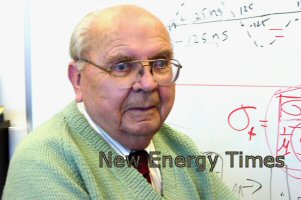U.S. Navy LENR Researcher Stanislaw Szpak Dies

Stanislaw Szpak
Oct. 13, 2016 – By Steven B. Krivit –
Electrochemist and low-energy nuclear reaction (LENR) researcher Stanislaw Szpak, 95, died yesterday, according to his colleague Frank Gordon. Szpak and Gordon were part of a small LENR team at the U.S. Navy’s Space and Naval Warfare Systems Center (SPAWAR) in San Diego, California.
The initial core SPAWAR LENR group consisted of Szpak (b. 1920), Pamela Mosier-Boss (b. 1957), and Jerry Smith (b. 1939), a chemist who worked for the Department of Energy (DOE). In the first two decades of the field, the SPAWAR group was the only U.S. government group to consistently publish the LENR research in the open, peer-reviewed literature. A primary reason for the continuation of the SPAWAR LENR work and the publication of the group’s results was the support of Frank Gordon (b. 1944), who, in 1989, was the head of the Department of Anti-Submarine Warfare at the San Diego laboratory, later renamed SPAWAR.
Szpak approached Gordon soon after Martin Fleischmann and Stanley Pons’ room-temperature “fusion” announcement and asked for his support to work on experiments. Gordon recognized the value and potential importance of the research and provided discretionary funding to support Szpak’s research group. Gordon also had enough clout to fend off naysayers who occasionally challenged the legitimacy of the group’s work on what many people at the time thought was bogus science.
According to Gordon, Szpak was born in the U.S., but when he was 2, his parents moved back to Poland. As a young man, he was studying chemistry when World War II broke out. At the time, Hitler’s troops were everywhere, confiscating everything they could to use for the war effort, including leather. Normally, the process of tanning leather took many days and was very smelly. It was virtually impossible for private leather industries to evade Hitler’s troops. Szpak used his chemistry know-how to develop a way to tan leather very quickly and thus evade detection. Szpak survived the era but at one point suffered a partial loss of sight in one eye and hearing in one ear when a nearby land mine exploded.
Szpak didn’t like the idea of waiting weeks, let alone months, for the necessary amount of deuterium to load into palladium, as Fleischmann and Pons had done. High ratios of deuterium and palladium atoms were a prerequisite before anything unusual would happen in the cells. Szpak’s Ph.D. dissertation had been on electrodeposition, an electrolytic process in which a thin layer of a metal is deposited on top of another metal. It was natural for him to think of using this method.
He and Mosier-Boss used electrodeposition to co-deposit atoms of palladium from a palladium-chloride solution onto cathodes (substrates) made of copper foil or nickel screens, metals that did not absorb deuterium. The result was that deuterium and palladium atoms from the solution deposited onto the substrates at a high deuterium-to-palladium atomic ratio, layer by layer, right from the beginning of the experiments.
By 2012, the SPAWAR group had published 25 LENR papers in peer-reviewed journals, more than any other individual or group in the U.S. Worldwide, only one group, in Japan, even came close and tied the SPAWAR group’s publishing record in LENRs. In two decades, the SPAWAR team, thanks to Szpak, made a wide variety of contributions to the body of experimental research in LENRs.
Questions? Comments? Submit a Letter to the Editor.

